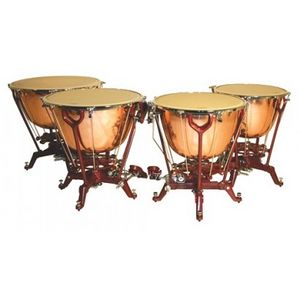Difference between revisions of "Timpani"
| Line 43: | Line 43: | ||
Early sticks used for kettle drums consisted of wood or the occasional ivory. The shafts were short and the head of the stick was small as well. The sound produced by these early forms of sticks was loud and dry which was ideal for the ceremonial music of mounted kettledrummers. | Early sticks used for kettle drums consisted of wood or the occasional ivory. The shafts were short and the head of the stick was small as well. The sound produced by these early forms of sticks was loud and dry which was ideal for the ceremonial music of mounted kettledrummers. | ||
More subtle approaches to sound production, for such events as funeral processions, the players would wrap the ends of their sticks with woolen cloth or chamois. | More subtle approaches to sound production, for such events as funeral processions, the players would wrap the ends of their sticks with woolen cloth or chamois. | ||
| − | Covered sticks of varying material became more prevalent due to the loud and unvarying nature of the wooden sticks.<br/> | + | Covered sticks of varying material became more prevalent due to the loud and unvarying nature of the wooden sticks. |
| + | <ref>John H., Beck. Encyclopedia of Percussion. New York & London: Garland Publishing, Inc., 1995. (accessed January 19, 2013).<ref> <br/> | ||
== Performance Technique == | == Performance Technique == | ||
Revision as of 00:35, 20 January 2013
 Range of Timpani | |
 | |
| Timpani | |
|---|---|
| Range of Timpani |
Timpani is the more common plural form of the Italian name for kettledrums. They are a type of drum consisting of a membrane stretched over a vessel-shaped bowl or body made primarily from metal. The bowl acts to resonate vibrations created by striking the head resulting in a definite pitch.
Etymology and Alternative Spellings
Fr: timbale(s); Ger: pauken; It: timpano(i); Sp: timbals, atabul
Construction
The bowl of the timpani is usually made from copper alloy although some models come in fiberglass. This bowl acts as a resonator for the vibrations of the enclosed air created by striking the head. The heads, plastic or calfskin, are stretch across the top of the bowl and mounted on a hoop that is then secured down by a metal ring called the counterhoop. A number of threaded screws pass through the counterhoop and attach to the bowl and allow for variations in the skin's tension.
Basic Timpani
Machine Timpani
Pedal Timpani
Chain Timpani
History
Sticks, Mallets, Beaters
Early sticks used for kettle drums consisted of wood or the occasional ivory. The shafts were short and the head of the stick was small as well. The sound produced by these early forms of sticks was loud and dry which was ideal for the ceremonial music of mounted kettledrummers.
More subtle approaches to sound production, for such events as funeral processions, the players would wrap the ends of their sticks with woolen cloth or chamois.
Covered sticks of varying material became more prevalent due to the loud and unvarying nature of the wooden sticks.
<ref>John H., Beck. Encyclopedia of Percussion. New York & London: Garland Publishing, Inc., 1995. (accessed January 19, 2013).<ref>
Performance Technique
Grips
Stroke Style/Type
Tuning
Muffling
Extended Technique
Manufacturers
Head Replacement
Basics I
Spring Tension Style
Dresden Style
Goodman Chain Style
Retailers
See Also
References